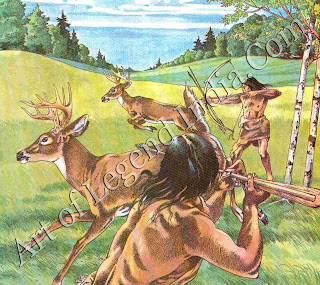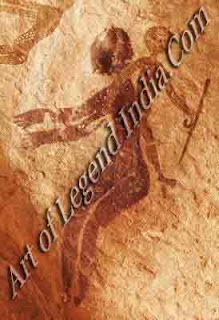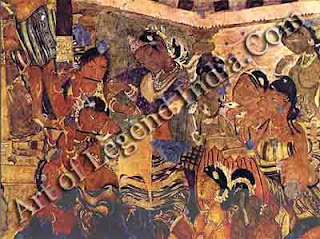 Prehistoric
Prehistoric
The
earliest paintings in India have been found in primitive caves and
rock-shelters in Mirzapur and Banda in Uttar Pradesh, in the Mahadev hills of
the Vindhyan range in Bundelkhand, in the Kaimur hills in the area of
Bagelkhand, in Singanpur in Raigarh district of Central India and Bellary in
the South. These paintings are mainly hunting scenes representing man in his
encounter with wild animals.
In
Singanpur, the cavern is in a ruined state with an amount of debris obstructing
the entrance. There have been recovered here several objects of prehistoric man
which would give a clue to help surmise the date of these cave-dwellers and
their art. The paintings, though in a crude technique, represent vivid pictures
of hunt. Red pigment has been freely used. Some of the figures have got washed
off. In a well-preserved scene, there is the hunt of a bison and a sambhar. The
human figures are conventionalised. The torso is sometimes drawn as almost a
ladder composed of steps; sometimes it is a silhouetted figure with the head
dominating the rest of the body, the hands and feet in all cases appearing as
just straight or bent lines. Their handling pikes and javelins in their effort
to attack the animal is indeed most lively. One of the animals at Singanpur
represents a barking dog, rushing forward at a terrific pace, the tail
stretched out and the legs indicating the speed of its motion. This is in
contrast with the stylised form in many of the human figures. These paintings
have affinities with similar primitive paintings of Cogul in Spain.
 Interesting
prehistoric paintings have been discovered in the rock-shelters of the Kaimur
range. At Bhalduria in Mirzapur district, there is a scene of stag hunt where
harpoons and spears are depicted in action. Harpoons again occur in the attack
of an animal in paintings from the Lohri cave. In the Likhunia rock-shelter in
the Son valley, there is another stag hunt represented. In all these cases, it
is the cave-man, using flint weapons like a stone spear that is depicted. An
interesting scene of a rhinoceros hunt occurs in the Ghormangar cave. A group
of six men attack the animal. The scene is quite animated as the rhino is
giving good battle. The animal is so enraged that he is undaunted by the barbs
and spears used against him. There are other similar scenes of rhinoceros hunts
at the Harin Hama cave, at Roup and other places.
Interesting
prehistoric paintings have been discovered in the rock-shelters of the Kaimur
range. At Bhalduria in Mirzapur district, there is a scene of stag hunt where
harpoons and spears are depicted in action. Harpoons again occur in the attack
of an animal in paintings from the Lohri cave. In the Likhunia rock-shelter in
the Son valley, there is another stag hunt represented. In all these cases, it
is the cave-man, using flint weapons like a stone spear that is depicted. An
interesting scene of a rhinoceros hunt occurs in the Ghormangar cave. A group
of six men attack the animal. The scene is quite animated as the rhino is
giving good battle. The animal is so enraged that he is undaunted by the barbs
and spears used against him. There are other similar scenes of rhinoceros hunts
at the Harin Hama cave, at Roup and other places.
Similarly,
hunting scenes painted in red occur in the Vindhyan area at Sarhat, Kuria Kund
and Karpatia. At Pachmarhi and Hoshangabad in the Mahadev Hills, there are
several rock-shelters with similar paintings depicting hunting and pastoral
scenes. The scenes and the subjugation of two wild animals in a Monte Rosa
shelter and a monkey playing the flute in upper Dorothy Deep shelter at
Pachmarhi are very interesting.
Artistic
work of a similar nature has been found at Kapgallu in Benary district in the
south, where, besides hunting scenes depicting a bison fight, there are figures
of elephants, birds and humped and horned bulls.
In
Malabar, in the Edakal cave, Wainad, there are conventionalised human animal
figures and several simple carvings, but here there are other ancient and
medieval inscriptions, which are probably much late than the earlier executed
carvings, which were completely covered up, till they were exposed, when they
were discovered early in this century.
Writer-C.SIVARAMAMURTI
 Prehistoric
Prehistoric Interesting
prehistoric paintings have been discovered in the rock-shelters of the Kaimur
range. At Bhalduria in Mirzapur district, there is a scene of stag hunt where
harpoons and spears are depicted in action. Harpoons again occur in the attack
of an animal in paintings from the Lohri cave. In the Likhunia rock-shelter in
the Son valley, there is another stag hunt represented. In all these cases, it
is the cave-man, using flint weapons like a stone spear that is depicted. An
interesting scene of a rhinoceros hunt occurs in the Ghormangar cave. A group
of six men attack the animal. The scene is quite animated as the rhino is
giving good battle. The animal is so enraged that he is undaunted by the barbs
and spears used against him. There are other similar scenes of rhinoceros hunts
at the Harin Hama cave, at Roup and other places.
Interesting
prehistoric paintings have been discovered in the rock-shelters of the Kaimur
range. At Bhalduria in Mirzapur district, there is a scene of stag hunt where
harpoons and spears are depicted in action. Harpoons again occur in the attack
of an animal in paintings from the Lohri cave. In the Likhunia rock-shelter in
the Son valley, there is another stag hunt represented. In all these cases, it
is the cave-man, using flint weapons like a stone spear that is depicted. An
interesting scene of a rhinoceros hunt occurs in the Ghormangar cave. A group
of six men attack the animal. The scene is quite animated as the rhino is
giving good battle. The animal is so enraged that he is undaunted by the barbs
and spears used against him. There are other similar scenes of rhinoceros hunts
at the Harin Hama cave, at Roup and other places. 











0 Response to "Introduction to Prehistoric-Indian Painting"
Post a Comment